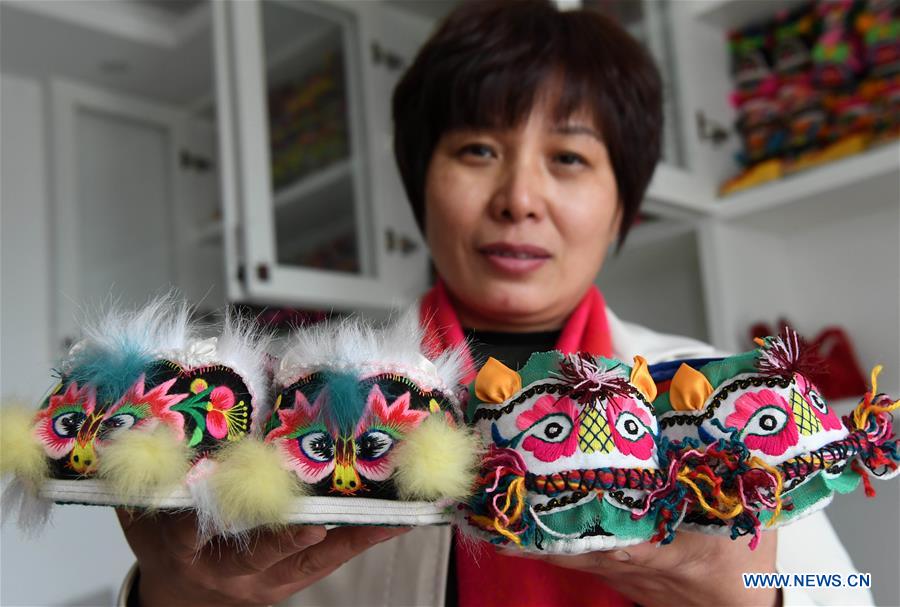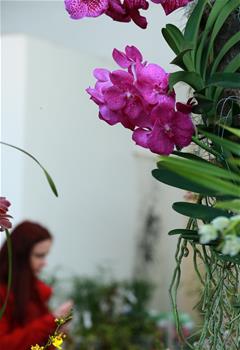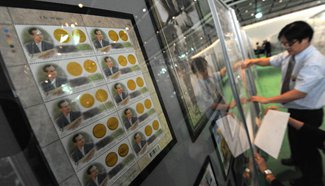Collector Hu Shuqing displays her collection of tiger-head shoes in Zhengzhou City of central China's Henan Province, March 10, 2017. Hu collected more than 10,000 tiger-head shoes. This type of shoes is traditional Chinese folk handicraft used as footwear for children with the hope that children will become as robust and dynamic as tigers. (Xinhua/Zhu Xiang)
ZHENGZHOU, March 11 (Xinhua) -- For centuries, tiger-head shoes were all the rage for children in north China, if not the entire country, until about 30 years ago.
Now, like the animal itself, the traditional footwear is on the edge of extinction.
Hu Shuqing, 51, from central China's Henan province, has spent 17 years collecting more than 10,000 pairs of the shoes.
"I will give most of these shoes to public museums, so that our next generation and the one after can see them," she said.
Chinese people began making tiger-head shoes in ancient times. In China, the tiger was seen as king of all animals. People used to believe that its image would protect toddlers from evil.
Some parents told their children a folk tale about the shoes. A wicked official abducted the beautiful wife of a boatman. Missing his mother badly, her son went to see the official in a pair of tiger-head shoes. The official refused to let the woman go and the shoes suddenly turned into two tigers and killed him, so the family were finally reunited.
Tiger-head shoes had many variants. Some people use frogs or peacocks, while others sewed obnoxious animals, including spiders, snakes and scorpions.
Hu was born into a family of paper-cutters, but her mom and grandma both made tiger-head shoes. "My daughter grew up wearing the shoes her grandma made," she said. Back then she was too young to see the shoes as special.
In 2000, she was attracted by a pair of tiger-head shoes at a temple fair, a festival at Chinese New Year which often features performances and folk markets.
"The tigers on the shoes were embroidered according to paper-cutting patterns," she said.
From that day forth, she has collected the shoes, first in Qixian county, her home, then farther and into other provinces like Hebei and Shandong.
Normally she travels between September and December. "Kids wear tiger-head shoes in winter," she said. "They are pretty and warm."
An intangible cultural heritage inheritor herself, Hu earns about 200,000 yuan (about 29,000 U.S. dollars) a year. She spends most of her money on traveling and purchases.
A pair of shoes can cost anything from 12 to 150 yuan, but they are not easy to buy.
She remembers a granny in her 70s in a nearby village. "I visited her three times, but she refused to sell the shoes," Hu said. The granny was making the shoes for her grandson.
"The shoes were handmade and unique." Hu decided to try again. The fourth time, she bought gifts for the family. Touched by her persistence, the granny gave her two pairs.
Four bookshelves and two basement rooms in Hu's home are now piled high with tiger-head shoes, mostly red and yellow.
Women in the countryside normally make tiger-head shoes during off-season for farming. One woman can make more than ten pairs a year.
As China develops, young parents prefer more fashionable clothes and shoes for their children. Even Hu's granddaughter did not wear tiger-head shoes when she was a toddler.
"There are less in demand. As a result, fewer people still want to make them," Hu said.
The craftsmen with best skills are in their 80s or 90s, and even the youngest are over 60. "They are dying out," Hu said with a sigh.
Ten years ago, she met a centenarian at a temple fair. Her nephew was selling the shoes she made, with unusual spider and lizard patterns.
"I liked her shoes so much that I bought six pairs," Hu recalled. "The next year I visited her, only to be told that she had already passed away."
Also an inheritor of cultural heritage, Hu feels the pain. Her 32-year-old daughter is learning paper-cutting, and her five-year-old granddaughter, too. But Hu cannot make tiger-head shoes.
She is worried that the craft may perish along with its inheritors. In the last two years, she has not found a single pair of new shoes.
"Apart from those I am going to give to museums, I will keep some at home, and tell the children the stories behind the shoes."












